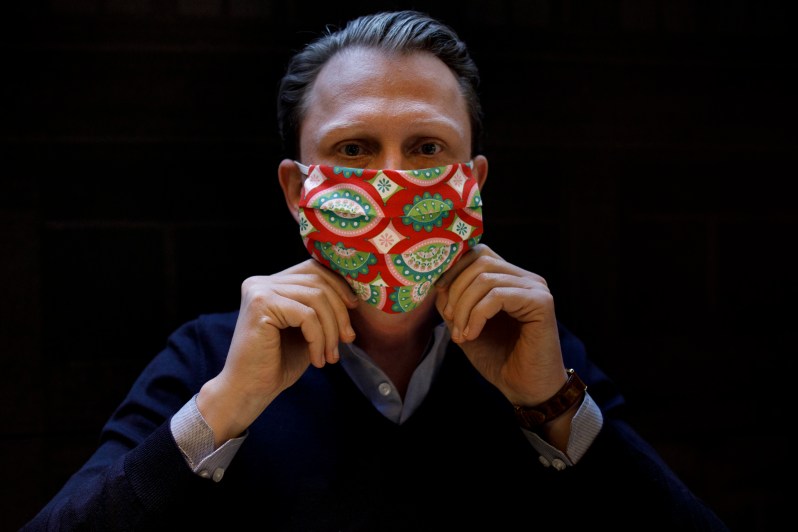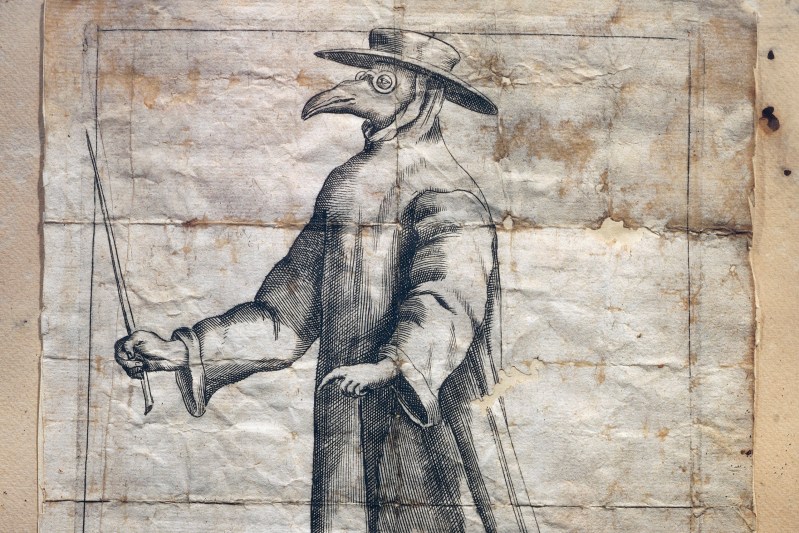
For men, it’s generally held that fewer accessories are better: grab a good watch, a signet (or wedding) ring, and maybe a tasteful pair of cufflinks to complete your outfit. That advice seems even more apropos for today’s work-from-home style, where a reliable pair of noise-cancelling earbuds may seemingly be the only essential accessory. But COVID-19 has other ideas for us: Last week, the Centers for Disease Control recommended that we all wear “cloth face coverings” outside in order to slow the coronavirus’ spread. However, scarce surgical masks and N-95 respirators should be left to healthcare workers who need them most.
Why We Should Be Wearing Face Masks
In an NPR interview on Monday; Dr. Harvey Fineberg of the National Academies Standing Committee on Emerging Infectious Diseases explained that the COVID-19 virus can be spread by droplets. “You know when someone is shouting in your face or talking at you, or laughing and you feel the spray? That’s a large droplet.”
Fineberg went on to explain that we also create tiny droplets when we talk and breath, creating “bioaerosol particles.” Those can float around, never dropping to the ground. “It’s important that, in closed spaces like patient care rooms, our health care professionals have the right goggles as well as the masks,” he says. Wearing a protective covering, even if it’s just a cloth mask, can help prevent those droplets from spreading.
Of course, cloth masks aren’t as effective as N-95 masks. One 2015 study showed that 97% of particles pass through cloth masks, compared to only 44% through medical masks, but doctors like Matthew Fox still recommend civilians to cover their faces in public.
“In fact, [cloth masks] probably doesn’t actually afford that much protection to the wearer,” Fox, a professor in the departments of epidemiology and global health at Boston University, tells The Manual. “But if all of us have these masks in front of our mouth and nose, we are less likely to emit these particles that could infect someone else.”
He says that face coverings are essential to wear in places where strangers are gathering, including groceries, hardware stores, the pharmacy, and so on, but there’s no need to wear them at home, as you share the same risk pool with people you live with.
“Many people feel their risk of contracting the virus is low, but you have to think about this not being just for yourself, but for other people,” Fox says. “You can have the disease, not know it, and spread it to other people. If you choose not to wear protection, what is the risk to me, or to the other people around you?”
Also, he notes to make sure that your nose and mouth are completely covered.
“One of the best things about wearing a mask is that it will also remind you not to touch your face when you’re outside,” Fox says. “And, of course, a thorough hand-washing when you get home is the best thing you can do.”
The History of Pandemics and Face Masks

As far back as the 14th century, plague doctors began wearing masks to protect themselves from pandemics like the Black Death, also known as the bubonic plague. Nearly 300 years later, French doctor Charles de Lorme invented the infamous “beak doctor” costume; its bird-like, long-beaked mask stuffed with medicinal herbs and spices to protect the wearer from “miasma,” or bad air. While these may present a certain sartorial splendor, they’re probably not going to go over so well on your socially-distanced trip to the supermarket.
Fast forward to the late 1800s, and another Frenchman, Paul Berger, became the first doctor to wear a surgical mask when he figured out that spit from the mouth of the surgeon (or any of his team members) might spread pathogens and cause infections in his patients.
By the 21st century, and—up until recently—most of us wear masks to protect ourselves like wearing dust masks while doing woodworking or painting, or balaclavas while skiing. Meanwhile the Japanese have been wearing face coverings since the Spanish Flu pandemic of 1918, which was meant to avoid spreading one’s own germs to others.
In January, when the coronavirus pandemic arrived to the United States, it seemed like anyone with a sewing machine—from home sewers to apparel manufacturers—stepped into the breach to crank out homemade masks to negate a shortage of Personal Protective Equipment (PPE). Healthcare workers were using these home-grown versions to extend the life of professional-grade masks that threatened to be in short supply.
How to Make Your Own Face Mask
In the past few weeks, local fashion designers have been churning out face masks to sell, and they’ve been selling out just as quickly. If you can’t buy one online, you can always make your own face covering at home.
Dawn Moothart, Founder and Pattern Maker at Portland Apparel Lab, suggests checking out these mask-making instructions and video tutorial from Deaconess Health System’s web site, which includes instructions for a pleated face covering with elastic or tied string variations.
For those of us who can’t sew, don’t despair! Actor and director Colin Hanks has created an ingenious way to transform a classic bandanna into an effective PPE of sorts. Hanks (who also helms Hanks Kerchiefs) shared this method on his Instagram feed; folding a bandana several times, then securing it with string to attach to the ears.
However, epidemiology professor Fox says, “a bandana is okay, but something more substantial is better. There are several sites out there that demonstrate how to make an effective barrier from a kitchen towel.”Business Insider also reported that layering two blue shop towels provided a pretty effective barrier.
Of course, you can also choose to go the gaiter route: These multifunctional knit fabric tubes can be worn tugged up to cover your nose and mouth, but then roll down onto your neck for a neckerchief vibe; or up onto your head as a headband. They are cooling, offer sun protection, and this one even repels insects.
“Remember that we are doing this for the benefit of everyone,” Fox says. “If we all protect each other, the longer it will take before you could get sick, and the more time we have to fight this virus.”


